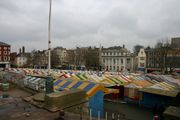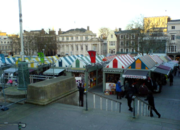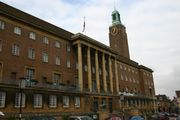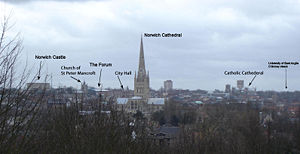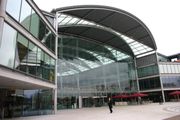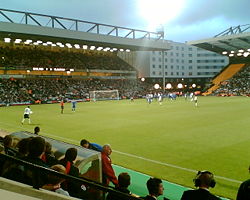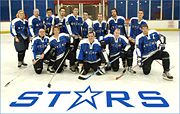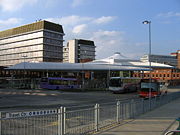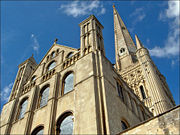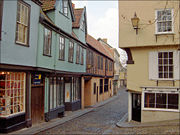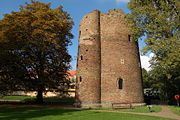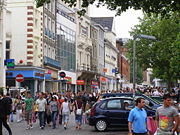Norwich
2008/9 Schools Wikipedia Selection. Related subjects: British Cities; Great Britain
| City of Norwich | |
|---|---|
 Shown within Norfolk |
|
| Geography | |
| Status: | City ( Time Immemorial) |
| Government Region: | East of England |
| Administrative County: | Norfolk |
| Area: - Total |
Ranked 322nd 39.02 km² |
| Admin. HQ: | Norwich |
| Grid reference: | TG 232 085 |
| ONS code: | 33UG |
| Demographics | |
| Population: - Total (2006 est.) - Density |
Ranked 147th 129,500 3319 / km² |
| Ethnicity: | 96.8% White 1.08% Mixed race 0.85% South Asian 0.38% Chinese 0.35% Black. |
| Heraldry | |
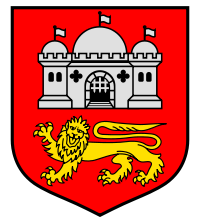 Arms of the City of Norwich Gules a Castle triple-towered and domed Argent in base a Lion passant guardant Or. |
|
| Politics | |
| Leadership: | Leader & Cabinet |
| Executive: | TBA (council NOC) |
| MPs: | Charles Clarke, Ian Gibson |
| Post Office and Telephone | |
| Postcode: | NR |
| Dialling Code: | 01603 |
Norwich ( pronunciation ; IPA: /ˈnɒrɪdʒ/), is a city in East Anglia, in Eastern England, UK. It is the regional administrative centre and county city of Norfolk. During the 11th century Norwich became the second largest city in England, after London, and one of the most important places in the kingdom.
The suburban area expands far beyond its boundary, with extensive suburban areas outside the city on the western, northern and eastern sides, including Thorpe St. Andrew on the eastern side. The Parliamentary seats cross over into adjacent local government districts. 121,600 (2006 est) people live in the Norwich City Council area and the population of the Norwich Travel to Work Area (i.e. the area of Norwich in which most people both live and work) is 367,035 (the 1991 figure was 351,340). Norwich is the fourth most densely populated Local Authority District within the East of England with 3,319 people per square kilometre (8,592 per square mile).
The Department for Communities and Local Government recently considered whether Norwich should become a unitary authority, separate from Norfolk County Council. It was not selected as one of the new creations in July 2007 as its proposals did not meet the strict criteria.
History
Roman
The Romans had their regional capital at Venta Icenorum on the river to the south which is near modern-day Caistor St Edmund.
Early English/Norman Conquest
There are two suggested models of development for Norwich. It is possible that three separate early Anglo-Saxon settlements, one on the north of the river and two either side on the south, joined together as they grew or that one Anglo-Saxon settlement, on the north of the river, emerged in the mid 7th century after the abandonment of the previous three. The ancient city was a thriving centre for trade and commerce in East Anglia in 1004 AD when it was raided and burnt by Swein Forkbeard the Viking. Mercian coins and shards of pottery from the Rhineland dating to the 8th century suggest that long distance trade was happening long before this. Between 924-939 AD Norwich became fully established as a town due to the fact that it had its own mint. The word Norvic appears on coins across Europe minted during this period, in the reign of King Athelstan. The Vikings were a strong cultural influence in Norwich for 40-50 years at the end of the 9th century, setting up an Anglo-Scandinavian district towards the north end of present day King Street.
At the time of the Norman Conquest the city was one of the largest in England. The Domesday Book states that it had approximately twenty-five churches and a population of between five and ten thousand. It also records the site of an Anglo-Saxon church in Tombland, the site of the Saxon market place and the later Norman cathedral. Norwich continued to be a major centre for trade, the River Wensum being a convenient export route to the sea. Quern stones, and other artifacts, from Scandinavia and the Rhineland have been found during excavations in Norwich city centre which date from the 11th century onwards.
The main area of Saxon settlement south of the Wensum was destroyed by the construction of the Norman castle (see Norwich Castle) during the 1070s. The Normans established a new focus of settlement around the Castle and the area to the west of it: this became known as the "New" or "French" borough, centred on the Norman's own Market Place which survives to the present day as the City's Provision Market.
In 1096, Herbert de Losinga, the Bishop of Thetford, began construction of Norwich Cathedral. The chief building material for the Cathedral was limestone, imported from Caen in Normandy. To transport the building stone to the cathedral site, a canal was cut from the river (from the site of present-day Pulls Ferry), all the way up to the east wall. Herbert de Losinga then moved his See there to what became the cathedral church for the Diocese of Norwich. The bishop of Norwich still signs himself Norvic.
Norwich received a royal charter from Henry II in 1158, and another one from Richard the Lionheart in 1194.
Middle Ages
By the middle of the 14th century the city walls, about two and a half miles (4 km) long, had been completed. These, along with the river, enclosed a larger area than that of the City of London. However, when the city walls were constructed it was made illegal to build outside them, inhibiting expansion of the city.
In 1144, the Jews of Norwich were accused of ritual murder after a boy ( William of Norwich) was found dead with stab wounds. This was the first incidence of blood libel in England. The story was turned into a cult, William acquiring the status of martyr and William was subsequently canonized. The cult of St. William attracted large numbers of pilgrims, bringing wealth to the local church. On February 6, 1190, all the Jews of Norwich were massacred except for a few who found refuge in the castle.
The wealth generated by the wool trade throughout the Middle Ages financed the construction of many fine churches and Norwich still has more medieval churches than any other city in Western Europe north of the Alps. Throughout this period Norwich established wide-ranging trading links with other parts of Europe, its markets stretching from Scandinavia to Spain. Around this time, the city was made a county corporate and became capital of one of the most densely populated and prosperous counties of England.
The great immigration of 1567 brought a substantial Walloon community of weavers to Norwich. Norwich has been the home of various dissident minorities, notably the French Huguenot and the Belgian Walloon communities in the sixteenth and seventeenth centuries. These immigrants were known locally as 'Strangers'. The merchant's house - now a museum - which was their earliest base in the city is still known as 'Strangers' Hall'. It seems that the Strangers were integrated into the local community without a great deal of animosity, at least among the business fraternity who had the most to gain from their skills. The arrival of the Strangers in Norwich bolstered trade with mainland Europe, fostering a movement toward religious reform and radical politics in the city. During this time Norwich became the second largest city in the country second only to London
English Civil Wars to Victorian Era
The eastern counties were profoundly Parliamentarian in nature and Norwich followed suit, at the cost of some discomfort to the Lord Mayor, a Royalist, and the bishop, Joseph Hall, a moderate but targeted because of his position.
The Norwich Canary was first introduced into England by Flemish refugees fleeing from Spanish persecution in the 1500s. They brought with them not only advanced techniques in textile working but also their pet canaries, which they began to breed locally. The canary is the emblem of the city's football team, Norwich City F.C., nicknamed "The Canaries".
In 1797 Thomas Bignold, a 36-year-old wine merchant and banker, founded the first Norwich Union Society. Some years earlier, when he moved from Kent to Norwich, Bignold had been unable to find anyone willing to insure him against the threat from highwaymen. With the entrepreneurial thought that nothing was impossible, and aware that in a city built largely of wood the threat of fire was uppermost in people's minds, Bignold formed the "Norwich Union Society for the Insurance of Houses, Stock and Merchandise from Fire". The new business, which became known as the Norwich Union Fire Insurance Office, was a "mutual" enterprise. Norwich Union was later to become the country's largest insurance giant.
Until the industrial revolution, as the capital of England's most populous and prosperous county, Norwich vied with Bristol as England's second city.
Norwich's geographical isolation was such that until 1845 when a railway connection was established, it was often quicker to travel to Amsterdam by boat than to London. The railway was introduced to Norwich by Morton Peto, who also built the line to Great Yarmouth.
From 1808 to 1814 Norwich hosted a station in the shutter telegraph chain which connected the Admiralty in London to its naval ships in the port of Great Yarmouth.
20th century
In the early part of the 20th century Norwich still had several major manufacturing industries. Among these were the manufacture of shoes (for example the Start-rite brand), clothing, joinery, and structural engineering as well as aircraft design and manufacture. Important employers included Boulton & Paul, Barnards (inventors of machine produced wire netting), and electrical engineers Laurence Scott and Electromotors.
Norwich also has a long association with chocolate manufacture, primarily through the local firm of Caley's, which began as a manufacturer and bottler of mineral water and later diversified into making chocolate and Christmas crackers. Caley's was acquired by Mackintosh in the 1930s. It merged with Rowntree's in 1969 to become Rowntree-Mackintosh; it finally was bought by Nestlé and closed down in 1996 with all operations moved to York, ending a 120-year association with Norwich. The factory existed on the site of what is now the Chapelfield development. Caley's chocolate has since made a reappearance as a brand, and is still produced in Norwich.
HMSO, once the official publishing and stationery arm of the British government and one of the largest print buyers, printers and suppliers of office equipment in the UK, moved most of its operations from London to Norwich in the 1970s.
Jarrolds, established in 1810, was a well-known printer and publisher.
Norwich suffered extensive bomb damage during World War II, affecting large parts of the old city centre and Victorian terrace housing around the centre. Industry and the rail infrastructure also suffered. The heaviest raids occurred on the nights of 27/28th and 29/ 30 April 1942; as part of the Baedeker raids (so called because Baedeker's series of tourist guides to the British Isles were used to select propaganda rich targets of cultural and historic significance rather than strategic importance). Lord Haw-Haw made reference to the imminent destruction of Norwich's new City Hall (completed in 1938), although in the event it survived unscathed. Significant targets hit included the Morgan's Brewery building, Colman's Wincarnis works, City Station, the Mackintosh chocolate factory, and shopping areas including St. Stephen's Street, St. Benedict's Street, the site of Bonds department store and Curls department store (now Debenhams).
Economy
Shopping
Norwich was the eighth most prosperous shopping destination in the UK in 2006. Norwich has an ancient market place, established by the Normans between 1071 and 1074, which is today the largest six-days-a-week open-air market in England. The market has recently been downsized and undergone redevelopment, and the new market stalls have proved controversial: with 20% less floorspace than the original stalls, higher rental and other charges, and inadequate rainwater handling, they have been unpopular with many stallholders and customers alike. Indeed, the local Norwich Evening News characterises Norwich Market as an ongoing conflict between the market traders and Norwich City Council, which operates the market.
The Mall Norwich (Castle Mall until 2007), a shopping mall designed by local practice Lambert, Scott & Innes and opened in 1993, presents an ingenious solution to the problem of sensitively accommodating new retail space in a historic city-centre environment - the building is largely concealed underground and built into the side of a hill, with a public park created on its roof in the area south of the Castle.
The new Chapelfield shopping mall has been built on the site where the Caleys (later Rowntree Mackintosh and Nestlé) chocolate factory once stood. Chapelfield opened in September 2005, and is described as 'a major new shopping experience', featuring a new flagship department store House of Fraser. Detractors have criticised Chapelfield as unnecessary and damaging to local businesses; its presence has prompted smaller retailers to band together to promote the virtues of independent shops. Despite this in August 2006 it was reported by the Javelin Group that Norwich was one of the top five retail destinations in the UK, and in October 2006 the city centre was voted the best in the UK, in a shopping satisfaction survey run by Goldfish Credit Card.
Business
The city's economy, originally chiefly industrial with shoemaking a large sector, has changed throughout the eighties and nineties to a service-based economy. Norwich Union, an Aviva company, still dominates these, but has been joined by other insurance and financial services companies.
New developments on the former Boulton and Paul site include the Riverside entertainment complex with nightclubs and other venues featuring the usual national leisure brands. Nearby, the football stadium is being upgraded with more residential property development alongside the river Wensum.
Archant, formerly known as Eastern Counties Newspapers (ECN) is a national publishing group that has grown out of the city's local newspaper, the Norwich Evening News and the regional Eastern Daily Press (EDP).
Norwich has long been associated with the manufacture of mustard. The world famous Colman's brand, with its yellow packaging, was founded in 1814 and continues to operate from its factory at Carrow. Colman's is now being exported world wide by its parent company Unilever (Unilever UK Export) putting Norwich on the map of British heritage brands. You also can find the Colman's gift shop in the centre of Norwich which sells all kind of Colman's related products.
Culture
The University of East Anglia on the outskirts of Norwich was one of the so-called plate glass universities founded in 1963, following the Robbins Report. UEA adopted the city's motto of independence Do different and is especially well-known for its creative writing programme; established by Malcolm Bradbury and Angus Wilson, its graduates including Kazuo Ishiguro and Ian McEwan. The university campus houses the Sainsbury Centre for Visual Arts. The city also has an art college, the Norwich School of Art & Design, located in the city centre. Additionally, the Norfolk and Norwich University Hospital on the city's periphery at Colney was opened in 2001.
Norwich Theatre Royal has been on its present site for nearly 250 years, the Act of Parliament in the tenth year of the reign of George II having been rescinded in 1761. The 1300-seat theatre hosts a mix of national touring productions including musicals, dance, drama, family shows, stand-up comedians, opera and pop.
The Forum, designed by Michael Hopkins and Partners and opened in 2002 is a building designed to house the Millennium Library, a replacement for the Norwich Central Library building which burned down in 1994, and the regional headquarters and television centre for BBC East. The building provides a venue for exhibitions, concerts and events, although the city still lacks a dedicated concert venue.
The Millennium Library contains the 2nd Air Division Memorial Library, a collection of material about American culture and the American relationship with East Anglia, especially the role of the United States Air Force on UK air bases throughout the Second World War and Cold War. Much of the collection was lost in the 1994 fire, but the collection has been restored by contributions from many veterans of the war, both European and American.
Recent attempts to shed the backwater image of Norwich and market it as a popular tourist destination, as well as a centre for science, commerce, culture and the arts, have included the refurbishment of the Norwich Castle Museum and the opening of the Forum. The proposed new slogan for Norwich, England's Other City, has been the subject of much discussion and controversy - and it remains to be seen whether it will be finally adopted. A number of signs at the approaches to the city still display the traditional phrase - "Norwich - a fine city."
As part of ambitious aims to promote Norwich's heritage internationally, Norwich 12 has been launched - the UK's finest collection of individually outstanding heritage buildings spanning the Norman, medieval, Georgian, Victorian and modern eras. The group consists of: Norwich Castle, Norwich Cathedral, The Great Hospital, The Halls - St Andrew's and Blackfriars', The Guildhall, Dragon Hall, The Assembly House, St James Mill, St John's Roman Catholic Cathedral, Surrey House, City Hall and The Forum. Seen as a group they form an internationally important showcase of English urban and cultural development over the last millennium. In 2006 Norwich Heritage Economic and Regeneration Trust (HEART) secured almost £1 million from HM Treasury's Invest to Save budget to launch the Norwich 12 initiative.
Art & Music
Each year the Norfolk and Norwich Festival celebrates the arts, drawing many visitors into the city from all over eastern England. The Norwich Twenty Group, founded in 1944, presents exhibitions of its members to promote awareness of modern art. Norwich Arts Centre is a notable live music venue, concert hall and theatre located in St. Benedict's Street.
Sport
The principal local football team is Norwich City, also known as the Canaries, who play in the Football League Championship. Majority-owned by celebrity chef Delia Smith and her husband Michael Wynn-Jones, their ground is at Carrow Road. They have a strong East Anglian rivalry with Ipswich Town.
The city's second club, Norwich United (who are based in Blofield some 5 miles east of the city) play in the Eastern Counties league, whilst Norwich Union play in the Anglian Combination. The now-defunct Gothic F.C. were also based in Norwich.
Norwich also has an athletics club, City of Norwich AC (CoNAC), a rugby club, the Norwich Lions, an ice hockey team, the Norwich North Stars, and five field hockey clubs, University of East Anglia Hockey Club, Norwich City Hockey Club, Norwich Union Hockey Club, Norfolk Nomads Hockey Club and the Veterans only side Norwich Exiles. Outside the city boundary, the Norfolk Ski and Snowboarding club is located at Whitlingham Lane in Trowse.
Speedway racing was staged in Norwich both before and after WWII at The Firs Stadium in Holt Road, Hellesdon. The Norwich Stars raced in the Northern League of 1946 and the National League Division Two between 1947 and 1951, winning it in 1951. They were subsequently elevated to the Speedway National League and raced at the top flight until the stadium was closed at the end of the 1964 season. One meeting was staged at a venue at Hevingham but the event, staged without an official permit, did not lead to a revival of the sport in the Norwich area.
Perception
Norwich is sometimes portrayed in the UK media as a place which is remote, unsophisticated, gauche, and out-of-step with national trends (see Alan Partridge). This is perhaps primarily due to its geographical isolation, and an identification of Norwich as the epitome of Norfolk, a largely rural county.
Reality
However, Norwich was the second city of England (after London) for several centuries before industrialisation, which came late to Norwich due to its isolation.
Norwich also has a long history of political radicalism and is by no means a conservative city. With 13 seats, Green Party councillors make up the official opposition on Norwich City Council. The largest number of seats, however, is held by the Labour Party with 15; the Liberal Democrats are in third place with 6. The Conservative Party is currently in fourth place with 5 councillors.
In November 2006 the city was voted the greenest in the UK. There is currently an initiative taking place to make it a transition town. Norwich has recently been the scene of open discussions in public spaces, known as ' meet in the street', that cover social and political issues.
According to the 2001 census, 27.8% of respondents in Norwich stated that they were of "no religion", the highest percentage in England.
There are good rail links from Norwich railway station to Peterborough and London, and direct services to Cambridge were added in 2004. It is a commuter city, with packed services running on the train route between Norwich and London. Travelling by train to London from Norwich, travellers arrive in at Liverpool Street Station, in the heart of the 'city of London', the central financial district.
A large proportion of the population of Norwich are users of the Internet. A recent article has suggested that, compared with other UK cities, it is top of the league for the percentage of population who use the popular Internet auction site eBay. The city has also unveiled the biggest free Wi-Fi network in the UK, which opened in July 2006. Open Link will be undergoing essential work during august
In August 2007 Norwich was shortlisted as one of nine finalists its population group for the International Awards for Liveable Communities LivCom Awards The city eventually won a silver award in the small city category."
Transport
Road
Norwich sits astride the A47 (bypassed to the south of the city) which connects it with Great Yarmouth to the east and with Kings Lynn to the west, which ultimately connects to Peterborough. At present the A47 is in the planning stages of upgrades, largely to sections which are still single-carriageway and with much focus on improving the road network in conjunction with the in-construction Great Yarmouth Harbour. Norwich is linked to Cambridge via the A11, which leads to the M11 motorway for London and the M25. It is linked to Ipswich (to the south) by the A140 and to Lowestoft (to the south-east) by the A146. Norwich is currently the largest population centre in the UK not to be connected to any other centre by an unbroken dual carriageway.
Rail
Rail links to the rest of the country are via London Liverpool Street Station and Peterborough. Local lines also run to destinations including Great Yarmouth, Lowestoft and Sheringham and Cambridge. Norwich formerly had three stations running to a number of other local destinations, but now the rail terminus is at Thorpe Station.
Current Station
- Norwich Thorpe railway station
Closed Stations
- Norwich City railway station
- Norwich Victoria railway station
Bus and coach
Norwich is served by many bus operators. The main bus operator is First Eastern Counties with their Overground network served by low floor buses and other routes served with a mixture of low floor and standard floor vehicles. Destinations throughout Norfolk are served and some beyond including Peterborough, Lowestoft and Thetford. National Express also run ten coaches a day to Stansted Airport, five a day to London, and one a day to Birmingham. Most bus and coach services, run from Norwich bus station in Surrey Street.
Park and Ride
As of 2005, Norwich had the biggest Park and Ride operation in the UK. Run by Norfolk County Council it runs from six purpose-built sites into Norwich bus station using colour-coded buses:
- Norwich Airport (off the A140) to the north via Aylsham Road; 620 spaces, yellow buses.
- Sprowston (off the A1151) to the northeast via Wroxham Road; 788 spaces, purple buses.
- Postwick (off the A47) to the east via Thorpe Road; 525 spaces, red buses.
- Harford (off the A140) to the south via Ipswich Road; 1088 spaces, blue buses.
- Thickthorn (of the A11) to the southwest via Newmarket Road; 786 spaces, pink buses.
- Costessey (off the A47) to the west via Dereham Road; 110 spaces, green buses.
Altogether nearly 5000 parking spaces are provided and in 2006 3.4 million passengers used the service. Services begin running into the city at 06:40 Monday to Friday, with the last buses returning from 19:25 (20:30 on Thursday).
Air
Norwich International Airport is a feeder to KLM's Schiphol hub. FlyBe, Air Southwest, Eastern Airways, and Bristow Helicopters all serve Norwich, in addition to a strong holiday charter flight business. The airport was originally the airfield part of the former RAF Horsham St Faith. One of the former RAF hangars was once the home of Air UK, which grew out of Air Anglia and was then absorbed by the Dutch airline KLM.
Bicycle
National Cycle Route 1 passes through Norwich, linking Beccles and Fakenham (and eventually Dover and the Shetland Islands). A map of cycle routes in and around Norwich is available here
Water
The River Yare is navigable from the sea at Great Yarmouth all the way to Trowse, south of the city. From there the River Wensum is navigable into Norwich, and is crossed by the Novi Sad Friendship Bridge. Scheduled trips through the city and out to the nearby The Broads are run by City Boats from outside Norwich Station and also Elm Hill.
Tourism
Norwich is a popular destination for a city break; attractions include Norwich Cathedral, the cobbled streets and museums of old Norwich, The Castle, Cow Tower, Colman's Shop, Dragon Hall and The Forum. Norwich is also one of the UK's top ten shopping destinations, with a mix of chain retailers and independent stores as well as one of the largest outdoor markets in England. It is currently ranked the 147th biggest city in Europe.
Travellers' comments
In 1507 the poet John Skelton (1460–1529) wrote of two destructive fires in his Lament for the City of Norwich.
- All life is brief, and frail all man's estate. City, farewell: I mourn thy cruel fate.
Thomas Fuller in his The Worthies of England described the City in 1662 as -
- Either a city in an orchard or an orchard in a city, so equally are houses and trees blended in it, so that the pleasure of the country and the populousness of the city meet here together. Yet in this mixture, the inhabitants participate nothing of the rusticalness of the one, but altogether the urbanity and civility of the other.
Celia Fiennes (1662–1741) visited Norwich in 1698 and described it as
- a city walled full round of towers, except on the river side which serves as a wall; they seem the best in repair of any walled city I know.
She also records that held in the City three times a year were-
- great fairs...to which resort a vast concourse of people and wares a full trade.
Norwich being a rich, thriving industrious place full of weaving, knitting and dyeing.
Daniel Defoe in his Tour of the whole Island of Great Britain (1724) wrote of the City-
- the inhabitants being all busy at their manufactures, dwell in their garrets at their looms, in their combing-shops, so they all them, twisting-mills, and other work-houses; almost all the works they are employed in being done within doors.
John Evelyn (1620–1706) Royalist, Traveller and Diarist wrote to Sir Thomas Browne-
- I hear Norwich is a place very much addicted to the flowery part.
He visited the City as a courtier to King Charles II in 1671 and described it thus -
- The suburbs are large, the prospect sweet, and other amenities, not omitting the flower-garden, which all the Inhabitants excel in of this City, the fabric of stuffs, which affords the Merchants, and brings a vast trade to this populous Town.
George Borrow in his semi-autobiographical novel Lavengro (1851) wrote of Norwich as-
- A fine old city, perhaps the most curious specimen at present extant of the genuine old English Town. ..There it spreads from north to south, with its venerable houses, its numerous gardens, its thrice twelve churches, its mighty mound....There is an old grey castle on top of that mighty mound: and yonder rising three hundred feet above the soil, from amongst those noble forest trees, behold that old Norman master-work, that cloud-enriched cathedral spire ...Now who can wonder that the children of that fine old city are proud, and offer up prayers for her prosperity?
Borrow wrote far less favourably of the City in his translation of Faust-
- They found the people of the place modelled after so unsightly a pattern, with such ugly figures and flat features that the devil owned he had never seen them equalled, except by the inhabitants of an English town, called Norwich, when dressed in their Sunday's best.
In 1812, Andrew Robertson wrote to the painter Constable-
- I arrived here a week ago and find it a place where the arts are very much cultivated....some branches of knowledge, chemistry, botany, etc. are carried to a great length. General literature seems to be pursued with an ardour which is astonishing when we consider that it does not contain a university, as is merely a manufacturing town.
In 1962, Sir Nikolaus Pevsner stated in his North-West Norfolk and Norwich volume of The Buildings of England that
- Norwich is distinguished by a prouder sense of civic responsibility than any other town of about the same size in Britain.
Notable residents
Throughout its history, Norwich has been associated with radical politics, nonconformist religion, political dissent and liberalism. Between 1790 and 1840, many of the famous names associated with the City flourished. These include:
- Michael Andrews (artist) (1928–1995)
- Elizabeth Bentley 1767-1839, author of "Tales for Children in Verse", lived at 45 St Stephen's Square.
- Billy Bluelight (1859/1863?–1949). Pseudonym of William Cullum. Legendary folk-hero, well known for his races against steam pleasure boats.
- George Borrow (1803–1881), writer and traveller. In his youth Borrow was resident at Willow Lane. He attended the Norwich King Edward school. Borrow recollects his youth in the city and conversations with the philologist and translator of German Romantic literature, William Taylor in his semi-autobiographical novel Lavengro.
- Sir Thomas Browne (1605–1682). medical doctor, polymath scholar, encyclopedist and philosopher with interests in Biblical scholarship and the esoteric. The stylistic purity and stupendous learning displayed in Browne's varied prose in the spheres of religion, science and art are minor classics of World literature.
- Edith Cavell (1865–1915) was born in Swardeston, 4 miles south of Norwich. She was a World War I nurse who was executed by firing squad by the Germans for helping allied prisoners escape in violation of military law. She is buried on Life's Green, on the east side of Norwich Cathedral.
- William Calthorpe who purchased in, 1447, as a town house, Erpingham manor in St.Martin's at the Palace, Norwich.
- John Crome and Joseph Stannard, along with John Sell Cotman, established the first art movement outside of London. The Norwich school of painters were influenced by the achievements of Dutch landscape painting and the beauty of the rural hinterland surrounding Norwich.
- William Crotch (1775–1847). Composer, artist and teacher. Norwich's Mozart. He gave daily public organ recitals aged two and a half. Crotch played God Save the King before the King aged three. He had performed at every major town in England and Scotland by the age of seven. Crotch became Organist of Christ Church, Oxford and for fifty years he was Oxford's Professor of Music. Unlike Mozart, however, his precocious musical talents failed to mature to genius.
- Pablo Fanque (1796–1871). The first Black Circus Proprietor in Britain was born in the city.
- Elizabeth Fry (1780–1845). The prison reformer and leading Quaker was born in Gurney Court in Magdalen Street and was one of several philanthropists associated with the city. Her portrait is upon the Series E (2005) Bank of England £5 note.
- Charles Suckling Gilman (1807–1888). Businessman, philanthropist. Founder, General Hailstorm Insurance Society, Norwich Mutual Marine Assurance Society, founder (with Joseph John Gurney) Norwich District Visiting Society.
- Sir Charles Rackham Gilman (1833 - ). Businessman, politician, philanthropist. Son of Charles Suckling Gilman. Mayor of Norwich, 1882, founder of the Norwich and London Accident Insurance Association, chairman of the conservators of Mousehold Heath. (Norwich's Gilman Road named for this family.)
- Joseph John Gurney (1788–1847) was a banker and philanthropist who worked with his sister Elizabeth Fry (see above) in prison reform. He was also active in the movement to abolish the slave trade and a member of the temperance movement.
- Robert William Bilton Hornby (1821–1884) was a noted local antiquarian, priest and lord of the manor from the City of York. He was ordained a deacon at Norwich in 1844.
- Julian of Norwich. Medieval Christian mystic and contemporary of Chaucer. Julian is the author of The revelations of Divine Love the first book written by a woman in the English language. Julian's writings are well-represented by the scholarly website www.umilta.net.
- Robert Kett. Norwich's very own Robin Hood or Wat Tyler. Kett was a Norfolk landowner from Wymondham who lead the peasant's revolt in 1549 in the name of the common man against the corrupt Norfolk landowners. This eventually lead to the Battle of Dussindale against the King's forces on the 27 August 1549 in which 3000 of Kett's men were killed. He was hanged for Treason at Norwich Castle on the 7 December 1549.
- James Martineau (1805–1900) Philosopher and brother to Harriet.
- Harriet Martineau (1802–1876). The daughter of a Norwich manufacturer of Huguenot descent, she suffered from ill-health and deafness throughout her life. A devout Unitarian , her writings include Illustrations of political economy (1832–1834). Harriet Martineau supported the abolitionist campaign in the United States writing Society in America (1837). She translated writings by Auguste Comte. Her first novel was entitled Deerbrook (1839). A radical in religion she published the anti-theological Laws of Man's Social Nature (1851) and Biographical sketches (1869).
- Bernard Meadows,(1915–2005) Modernist Sculptor
- R. H. Mottram (1883–1971)- novelist and Lord Mayor of Norwich
- Admiral Horatio Nelson attended the Norwich School from 1767 to 1768. He was born in nearby Burnham Thorpe.
- Amelia Opie (1769–1853), Norwich author and Quaker. In 1825 she drastically changed her life as a socialite, party-goer, and attendant at literary soirees, to become a Quaker.
- Sir James Edward Smith botanist, natural historian and one-time owner of the Linnean collection of Carolus Linnaeus
- William Smith (1756 – 1835), Whig politician, dissenter and abolitionist, M.P. for Norwich from 1807.
Contemporary names associated with Norwich include:
- Bill Bryson, American writer and humorist, lives near Wymondham, near Norwich.
- Martin Burgess, builder of the famous Gurney Clock in the Castle Mall
- Charles Clarke, Labour MP and former Home Secretary, lives in Norwich.
- Cathy Dennis, Singer/ Songwriter who was born in Norwich in 1969.
- Ralph Firman, former Formula 1 Driver was born in Norwich in 1975. He and his family live in nearby Attleborough, and he was educated at Gresham's School. Currently racing in the A1 Grand Prix series for Ireland, for which he qualifies through his Mother's Irish nationality.
- Stephen Fry, comedian, author, actor and filmmaker, studied at Norwich City College, and is a Norwich City F.C. fan.
- Trisha Goddard, talk show host lived in Norwich.
- Andy Green OBE, a Wing Commander in the Royal Air Force, is the current holder of the world land speed record, having piloted the ThrustSSC to the first ever supersonic speed on land in the Black Rock Desert, USA on 25 September 1997.
- Alan Heath - holocaust historian has his UK residence in Norwich.
- Greg James, BBC Radio 1 presenter, studied at UEA.
- Paul Jones, blues singer and BBC Radio 2 presenter.
- Becky Mantin, ITV Weather presenter and This Morning reporter.
- Bernard Matthews, founder of the eponymous meat company.
- Sir John Mills, born in North Elmham in Norfolk. Mills was educated at the Norwich High School for Boys. He also had Football (Soccer) trials with Norwich City F.C. in the 1920s before moving into acting.
- Beth Orton, Award-winning singer/songwriter, was born in Dereham and spent much of her childhood in Norwich.
- Philip Pullman, British writer was born in Norwich on 19 October 1946. Best-selling author of the His Dark Materials trilogy of fantasy novels and a number of other books.
- Delia Smith, Celebrity chef and joint majority owner of Norwich City F.C.
- Chris Sutton, Football player (striker); joint top scorer for the Premier League in 1997/8; formerly the record English transfer (at £5 million from Norwich to Blackburn in 1994); was brought up in Norwich attending Hellesdon High School where his father, Mike Sutton (footballer), was also a teacher.
- Tim Westwood, BBC Radio 1 Rap DJ and presenter of popular MTV show "Pimp My Ride (UK)". Grew up in and around Norwich (his father was the bishop of Peterborough, in the neighbouring county of Cambridgeshire) and went to Norwich School.
- Steve Osborne, musician and record producer - grew up in Norwich, left in 1986 to join Trident Studios - now lives near Bath and has produced both KT Tunstall albums amongst may others
Architecture
Norwich has a wealth of historical architecture. The medieval period is represented by the 11th-century Norwich Cathedral, 12th-century castle (now a museum) and a large number of parish churches. During the Middle Ages, 57 churches stood within the city wall; 31 still exist today. This gave rise to the common regional saying that it had a church for every week of the year, and a pub for every day. Most of the medieval building is in the city centre. From the 18th century the pre-eminent local name is Thomas Ivory, who built the Assembly Rooms (1776), the Octagon Chapel (1756), St Helen's House (1752) in the grounds of the Great Hospital, and innovative speculative housing in Surrey Street (c. 1761). Ivory should not be confused with the Irish architect of the same name and similar period.
The 19th century saw an explosion in Norwich's size and much of its housing stock, as well as commercial building in the city centre, dates from this period. The local architect of the Victorian and Edwardian periods who has continued to command most critical respect was George Skipper (1856–1948). Examples of his work include the headquarters of Norwich Union on Surrey Street; the Art Nouveau Royal Arcade; and the Hotel de Paris in the nearby seaside town of Cromer. The neo-Gothic Roman Catholic cathedral dedicated to St John the Baptist on Earlham Road, begun in 1882, is by George Gilbert Scott Junior and his brother, John Oldrid Scott.
The city continued to grow through the 20th century and much housing, particularly in areas further out from the city centre, dates from that century. The first notable building post-Skipper was the city hall by CH James and SR Pierce, opened in 1938. Bombing during the Second World War, while resulting in relatively little loss of life, caused significant damage to housing stock in the city centre. Much of the replacement postwar stock was designed by the local authority architect, David Percival. However, the major postwar development in Norwich from an architectural point of view was the opening of the University of East Anglia in 1964. Originally designed by Denys Lasdun (his design was never completely executed), it has been added to over subsequent decades by major names such as Norman Foster and Rick Mather.
Twinned cities
Officially:
Unofficially:
 El Viejo, Nicaragua.
El Viejo, Nicaragua.

